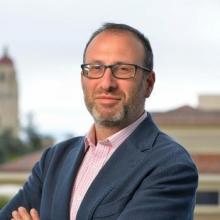IMSE Seminar with Alberto Salleo on How Electrons Move in Organic Semiconductors
Alberto Salleo, Stanford University, will be presenting the seminar "How Do Electrons Move in Organic Semiconductors? Linking Microstructure to Transport at Several Length Scales in Conjugated Polymers"
Carrier mobility in conjugated polymers continues to increase with recent reports of field-effect mobilities exceeding 10 cm2/V.s, a figure that would enable many exciting technologies such as flexible emissive displays, printed radio-frequency tags and stretchable skin-like electronics. From the materials science point of view, conjugated polymers are fascinating as they are neither entirely ordered or disordered exhibiting regularity at different length-scales. A comprehensive understanding of how electronic charges move through these materials is still missing however it is widely accepted that the polymer microstructure must play a role. At the molecular scale, I will show that the spatial arrangement of the molecules, as determined by synchrotron-based x-ray diffraction, plays a crucial role in charge delocalization. I will then show how we can study the nano and mesoscale organization of polymer crystals using new transmission electron microscopy techniques that take advantage of developments driven by the needs of the biology community. By using these techniques we are able to elucidate the microstructure across a range of length-scales in real space and in reciprocal space to extract quantitative information that is typically not visible by inspection of the micrographs. Modeling and experimental transport data are then used to put everything together and elucidate the roles of crystallinity, connectivity and molecular conformation in governing charge transport. This type of fundamental information is crucial for the systematic and rational design of new high-performance semiconducting polymers. Furthermore, we have recently designed nanocellulose as biofiller to synergistically improve bioplastics mechanical and biodegradable properties. Overall, these studies highlighted that lignocellulosic biomass can be broadly used as a biopolymer resource to design functional materials for addressing energy and environmental challenges.
Alberto Salleo is currently Professor of Materials Science and Department Chair at Stanford University. Alberto Salleo holds a Laurea degree in Chemistry from La Sapienza and graduated as a Fulbright Fellow with a PhD in Materials Science from UC Berkeley in 2001. From 2001 to 2005 Salleo was first post-doctoral research fellow and successively member of research staff at Xerox Palo Alto Research Center. In 2005 Salleo joined the Materials Science and Engineering Department at Stanford as an Assistant Professor. While at Stanford, Salleo won the NSF Career Award, the 3M Untenured Faculty Award, the SPIE Early Career Award, the Tau Beta Pi Excellence in Undergraduate Teaching Award, and the Gores Award for Excellence in Teaching, Stanford’s highest teaching award. He has been a Clarivate Highly Cited Researcher since 2015 and was elected to the European Academy of Sciences in 2021 and a Fellow of the Materials Research Society in 2022.


